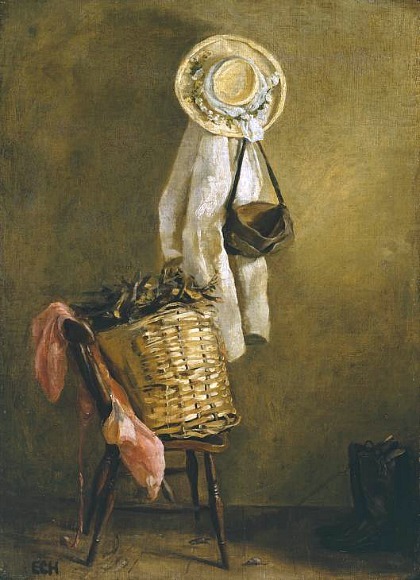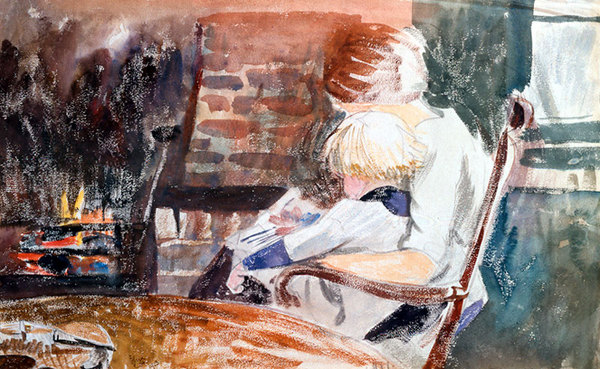Edward Thomas and three women, Edna, Eleanor and Helen
 |
| Still Life, Basket on Chair |
Edna Clarke Hall
Edna Clarke Hall and Edward Thomas met when both were about twenty and married.
 The Edna episodes that I wrote were by far the most
speculative, based chiefly on poems of Edward and Edna. Then belatedly my
speculations were to some extent confirmed by Matthew Hollis who had access to
Edna's journals of the period. But whether she actively tried to seduce Edward -
well, I can only say I think it quite likely, and likely that she would not have
succeeded.
The Edna episodes that I wrote were by far the most
speculative, based chiefly on poems of Edward and Edna. Then belatedly my
speculations were to some extent confirmed by Matthew Hollis who had access to
Edna's journals of the period. But whether she actively tried to seduce Edward -
well, I can only say I think it quite likely, and likely that she would not have
succeeded.Edna's Story:
Edna
– slender, extraordinarily beautiful, with a mass of chestnut hair and
expressive eyes, was so talented an artist that she was accepted at the Slade at
fourteen. She didn’t need to attend drawing class – there was nothing she needed
to learn – so she developed her own way as a painter, especially as a
water-colourist.
It
was William Clarke-Hall, a lawyer friend of her father’s, who had persuaded her
parents to send her to the Slade. In her mind Willie was of their generation,
twice her age. She was grateful to him but she’d never regarded him as a lover.
When he proposed marriage she was too young to know herself, her feelings, and
his nature. The marriage was unhappy from the beginning. Edna was nineteen,
Willie thirty-two, she was open, honest and forthright with her feelings, he was
reserved and formal, but he had been, for a time, overwhelmed by Edna’s
beauty.
Edward
had been in his last year at Oxford, already a father at twenty-one and married,
though not yet living with Helen. A close friend of his, a law student, knew
William and liked to talk about legal matters with him. Edward went on these
visits, but spent the time talking to Edna. It was ‘them and us’, as Edward said
– the lawyers and the artists.
Edna
was glad to have someone who understood her, because already her new husband
constantly criticised her behaviour and indeed her thoughts; he blamed her for
her introspection or what he called self-absorption. Worse, she was young and
wild, wanting to sleep out under the stars and climb the high elms around their
house. She went out barefoot in simple cotton dresses and Willie said she looked
like a gypsy.
Along
with her wildness was the problem, for Willie, of the informality and
spontaneity of her painting. Her art suffered; she managed to exhibit once in a
group with some old Slade friends, but nothing more. All her promise seemed to
have disappeared. She found what inspiration she could in Wuthering Heights, identifying herself
with Catherine and her yearning for passionate love, something that she felt was
cruelly denied her. She’d said a little, even at that early time, to Edward to
hint at her unhappiness but she’d restrained herself from too much complaint
then.
After
Oxford and a year in London the Thomases’ life took them away into the country,
to Kent and Hampshire, and the friendship faded. Fifteen years passed. Edna had
two children. Her old teacher from the Slade persuaded her to exhibit in a
one-woman show early in 1914, and in the Saturday Review she was described as a
sensitive and expressive draughtswoman. Her sense of colour, the reviewer said,
was individual and instinctive.
None
of this altered Willie’s attitude towards his wife.
In 1915 Edward's posting at Hare Hall camp, Romford,
meant that he was near enough the Clarke- Hall home, Great House, Upminster, to
visit and renew the friendship with Edna.
Hare Hall
Camp near Gidea Park, East of Romford, was three and a half miles
from Edna Clark-Hall, an hour's walk at most for him. I'm sure he would have
avoided the road, even then, and gone through parkland and fields.
The relationship between Edward and Edna was always something I felt very tentative about: having first heard of it, then learned a little more from Alison Thomas's work, I based everything else on the poems, his and hers. Matthew Hollis had access to Edna's diary, so long after I had written my novel I was able to see that I hadn't been far out in my speculations - but the account in A Conscious Englishman is fiction, more speculative than anything else in the novel.
It was clear that Edward enjoyed her company - and what a welcome change from the bare barracks hut her house must have been!
 |
| A- Hare Hall B- Great House, Hall Lane. |
The relationship between Edward and Edna was always something I felt very tentative about: having first heard of it, then learned a little more from Alison Thomas's work, I based everything else on the poems, his and hers. Matthew Hollis had access to Edna's diary, so long after I had written my novel I was able to see that I hadn't been far out in my speculations - but the account in A Conscious Englishman is fiction, more speculative than anything else in the novel.
It was clear that Edward enjoyed her company - and what a welcome change from the bare barracks hut her house must have been!
 |
| Great House |
From
A.C.E:
He
looked up at the tall chimneys of the fine eighteenth century house, its many
sash windows set in mellowed brick walls. William, Edna’s husband, was a very
successful barrister. He could imagine Edna in such a house, enjoying its
venerable romance. Would he be welcome, he
wondered.
He
tugged the iron pull and heard the bell deep inside the house, then footsteps
coming to the door. He knew suddenly how eager he was to see Edna again and to
watch her surprise, and, he hoped, pleasure at seeing him. But Edna was in
London that day, the servant who answered the door told
him.
After
a moment they recognised each other. She remembered Edward from the old
days.
‘The
mistress has two boys now, Mr Thomas – Justin and Denis. How is your little
boy?’
‘Not
so little. He’s fifteen and staying away from all this’ – he gestured at his
uniform – ‘in America at the moment. But I have daughters too, one just
thirteen, the other only five. Well, I’ll look forward to meeting Mr and Mrs
Clarke-Hall soon. My apologies to them for arriving with no
notice.’
Edna
Clark Hall and her beautiful house.
No
wonder Edward was drawn to visit when he could.
Characteristically,
Helen wrote to her after Edward's death that she was glad he had been able to
have that respite from the spartan uncongenial camp.

What
'happened' between them we don't know, but Edward's poems of the period
tell us that a real woman or 'Woman' preoccupied his thoughts.
I have a book of Edna's poems kindly sent to me by Alison Thomas.
The poems - well, I do wonder whether Edward was asked to read them and if so what he would have said. They are almost all full of pain, all too abstract to be effective, lacking Eliot's 'Objective Correlative'. Their subjects are often (capital letters) Love, Desire or Death.
These are rather better.
I have a book of Edna's poems kindly sent to me by Alison Thomas.
The poems - well, I do wonder whether Edward was asked to read them and if so what he would have said. They are almost all full of pain, all too abstract to be effective, lacking Eliot's 'Objective Correlative'. Their subjects are often (capital letters) Love, Desire or Death.
These are rather better.
The poems were
published in 1926 and none are dated.
Edna hated the war and was in effect a pacifist - she painted very little during the war years. Somewhere around 1918 she had a serious mental breakdown. Her therapist persuaded Willie, her husband, to respect her and her art more.
She had a studio and gallery in London and continued to paint.
Edna hated the war and was in effect a pacifist - she painted very little during the war years. Somewhere around 1918 she had a serious mental breakdown. Her therapist persuaded Willie, her husband, to respect her and her art more.
She had a studio and gallery in London and continued to paint.

In 1930 (aged 51) she was drawn by Augustus John.
(I have tried hard but failed to find COPYRIGHT information for any of these pictures. I apologise, and will remove them immediately if requested.)
Her gallery, studio and most of her extant work was destroyed in a bombing raid in WW Two, and she ceased painting. Edna lived till she was a hundred, dying in 1979.
Thomas's poem, written 4th March 1916
Celandine
Thinking of her had saddened me at first,
Until I saw the sun on the celandines lie
Redoubled, and she stood up like a flame,
A living thing, not what before I nursed,
The shadow I was growing to love almost,
The phantom, not the creature with bright eye
That I had thought never to see, once lost.
She found the celandines of February
Always before us all. Her nature and name
Were like those flowers, and now immediately
For a short swift eternity back she came,
Beautiful, happy, simply as when she wore
Her brightest bloom among the winter hues
Of all the world; and I was happy too,
Seeing the blossoms and the maiden who
Had seen them with me Februarys before,
Bending to them as in and out she trod
And laughed, with locks sweeping the mossy sod.
But this was a dream; the flowers were not true,
Until I stooped to pluck from the grass there
One of five petals and I smelt the juice
Which made me sigh, remembering she was no more,
Gone like a never perfectly recalled air.





It's wonderful to have found this blog. I will read your novel and let you know my thoughts on it. Congratulations!
ReplyDeleteI have a painting by Edna Thomas
ReplyDeleteIf you would like to see it email me. Thank you scottadenis@yahoo.com
Deleteuggs outlet store
ReplyDeletelongchamp outlet
cheap oakley sunglasses
canada goose outlet
milwaukee brewers jerseys
canada goose outlet
kobe shoes
gucci outlet
pandora outlet
fake rolex
cc20180930
replica bags online shopping replica bags and shoes replica bags online uae
ReplyDeletereplica bags in bangkok this link e0u33v6p16 replica bags uk image source v9t55w3i66 aaa replica bags replica bags for sale replica bags online pakistan find more information b2w22v4z54 replica kipling bags
ReplyDelete"I appreciate the clarity and professionalism in your writing. This post provides actionable insights supported by evidence."
ReplyDeleteFancy dresses online shopping Pakistan